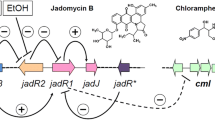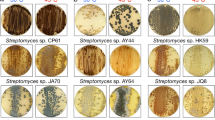Summary
The novel benzoxazolophenanthridine antibiotic, jadomycin B, is produced byStreptomyces venezuelae ISP5230 following a 42 °C heat shock or exposure to ethanol. To further characterize these unusual culture conditions, studies were carried out using different media, varying nutrient concentrations, initial pH, and time of application of heat or ethanol stress. Highest titers of jadomycin B accumulated 48 h afterS. venezuelae ISP5230 was inoculated into ad-galactose-l-isoleucine production medium (pH 7.5) which was supplemented with ethanol (6%, v/v) between 6 and 13 h. Cultures supplemented with ethanol later than 17 h post inoculation into the production medium produced little or no jadomycin B. Among other heat-shock inducing treatments examined, infection with phage SV1 was associated with increased jadomycin B production. Although jadomycin B titers showed little change with variations in the concentration of phosphate in the production medium, the nature of the nitrogen source was found to be important. Different colored pigments, presumed to be jadomycin B analogs, were formed when other amino acids replacedl-isoleucine in the medium as the sole nitrogen source. Increased jadomycin B titers accompanied increasedl-isoleucine andd-galactose concentrations in the production medium.
Similar content being viewed by others
References
Arnosti, D.N., V.L. Singer and M.J. Chamberlin. 1986. Characterization of heat shock inBacillus subtilis. J. Bacteriol. 168: 1243–1249.
Ayer, S.W., A.G. Mcinnes, P. Thibault, J.A. Walter, J.L. Doull, T. Parnell and L.C. Vining. 1991. Jadomycin, a novel 8H-benz[b]oxazolo[3,2-f]phenanthridine antibiotic fromStreptomyces venezuelae ISP5230. Tetrahedron Lett. 32: 6301–6304.
Bucca, G., M. Alberti, C.P. Smith and A.M. Puglia. 1991. Structure and regulation ofStreptomyces coelicolor dnak-like gene. 8th International Symposium on the Biology of Actinomycetes, No. P1-137, Madison, Wisconsin, August 11–16.
Chatterjee, S. and L.C. Vining. 1981. Nutrient utilization in actinomycetes. Induction of α-glucosidases inStreptomyces venezuelae. Can. J. Microbiol. 27: 639–645.
Doull, J.L. and L.C. Vining. 1992. Regulation of secondary metabolism. In: Industrial Biotechnology (Malik, V.S. and P. Sridhar, eds), pp. 179–188, International Science Publisher, New York.
Doull, J.L., S.W. Ayer, A.K. Singh and P. Thibault. 1993. Production of a novel polyketide antibiotic, jadomycin B, byStreptomyces venezuelae following heat-shock. J. Antibiotics 46: 869–871.
Drahos, D.J. and R.W. Hendrix. 1982. Effect of bacteriophage lambda infection on the synthesis ofgroE protein and otherEscherichia coli proteins. J. Bacteriol. 149: 1050–1063.
Folin, O. and H. Wu. 1920. A system of blood analysis. I. A simplified and improved method for determination of sugar. J. Biol. Chem. 41: 367–374.
Guglielmi, G., P. Mazodier, C.J. Thompson and J. Davies. 1991. A survey of the heat shock response in fourStreptomyces species reveals twogroEL-like genes and three GroEL-like proteins inStreptomyces albus. J. Bacteiol. 173: 7374–7381.
Herbert, D., P.J. Phipps and R.E. Strange. 1971. Chemical analysis of microbial cells. In: Methods in Microbiology, vol. 5B (Norris, J.R. and D.W. Ribbons, eds), pp. 228–229, Academic Press, New York.
Lee, J.-S., Y.-C. Hah and J.-H. Roe. 1993. The induction of oxidative enzymes inStreptomyces coelicolor upon hydrogen peroxide treatment. J. Gen. Microbiol. 139: 1013–1018.
Lee, P.C., B.R. Bochner and B.N. Ames. 1983. AppppA, heat-shock stress, and cell oxidation. Proc. Natl Acad. Sci. USA 80: 7496–7500.
Lindquist, S. 1986. The heat-shock response. Ann. Rev. Biochem. 55: 1151–1191.
Liras, P., J.A. Asturias and J.F. Martin. 1990. Phosphate control sequences involved in transcriptional regulation of antibiotic biosynthesis. Trends in Biotechnology 8: 184–189.
Qoronfleh, M.W., U.N. Streips and B.J. Wilkinson. 1990. Basic features of the staphylococcal heat shock response. Antonie van Leeuwenhoek 58: 79–86.
Roychowdhury, H.S. and M. Kapoor. 1988. Ethanol and carbon-source starvation enhance the accumulation of HSP80 inNeurospora crassa. Can. J. Microbiol. 34: 162–168.
Shapiro, S. and L.C. Vining. 1983. Nitrogen metabolism and chloramphenicol production inStreptomyces venezuelae. Can. J. Microbiol. 29: 1706–1714.
Stuttard, C. 1982. Temperate phages ofStreptomyces venezuelae: lysogeny and host specificity shown by phages SV1 and SV2. J. Gen. Microbiol. 128: 115–121.
Author information
Authors and Affiliations
Rights and permissions
About this article
Cite this article
Doull, J.L., Singh, A.K., Hoare, M. et al. Conditions for the production of jadomycin B byStreptomyces venezuelae ISP5230: Effects of heat shock, ethanol treatment and phage infection. Journal of Industrial Microbiology 13, 120–125 (1994). https://doi.org/10.1007/BF01584109
Received:
Accepted:
Issue Date:
DOI: https://doi.org/10.1007/BF01584109




